ANA’s Round the World award chart has long been revered for its fantastic business class award pricing. As Greg showed during our 3 Cards 3 Continents challenge last year, it doesn’t require a lot of miles to get a lot of mileage out of ANA’s round the world chart. But the other day, I got to wondering how their economy class round-the-world chart stacks up against stacking economy class award chart sweet spots. I thought that figuring that out might be a fun little exercise in award chart daydreaming, so here’s how the best options that came to mind stack up against each other. Feel free to hop into the comments with ideas of your own that could make the deal even better.
Stacking economy class award chart sweet spots
I spent a good deal of time contemplating the various economy class award chart sweet spots and trying to stitch them together into the best round-the-world price possible.
For the purposes of this post, I did check to find availability on all of the routes included in this section order to verify pricing and bookability.
I did not consider limited-time offers like Air France / KLM Flying Blue’s monthly promo rewards. Those awards change regularly with regard to which cities are available, but in months when US cities are included in the sale (which happens more often than not), the featured cities are most often available in economy class starting from 11,250 miles one-way. It may be possible to leverage a deal like that or Singapore’s Spontaneous Escapes or the recent Turkish Airlines award sale to improve upon my strategy a bit.
After spending hours searching various sites and using tools like Pointsyeah and Point.me, I was surprised at the result…
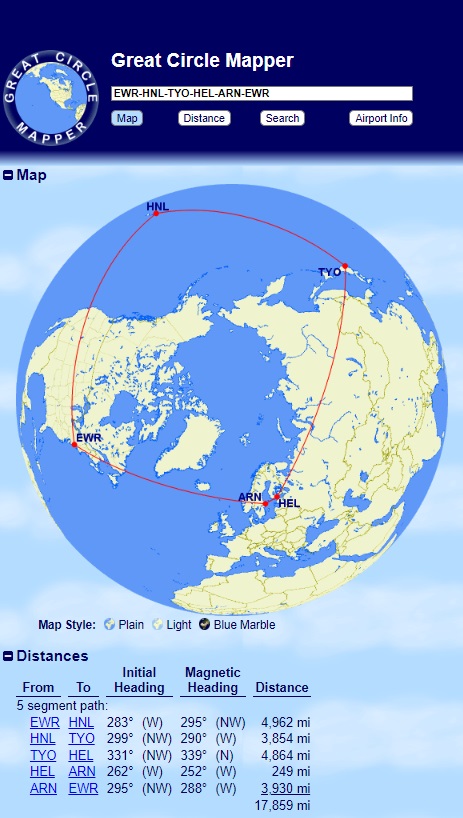
This was the cheapest economy class round-the-world ticket I came up with that circumnavigated the world using separate economy class sweet spots
Newark to Honolulu for 7.5K miles + $5.60
The first leg is of course the Turkish Miles & Smiles sweet spot, which is that Star Alliance domestic flights cost just 7,500 miles one-way. That sweet spot goes a long way here in that it covers nearly a third of the total round-the-world distance with one very cheap award. While these awards can be notoriously tough to find and book, I wrote about my success just this week in using this sweet spot to fly from Anchorage, Alaska to Chicago, so you should still be able to make Hawaii work with an email booking.
Honolulu to Tokyo for 22.5K miles + $5.60

During our 40K to Far Away challenge, I flew Delta airlines from Honolulu to Tokyo for just 20K Virgin Atlantic miles and $5.60. That award has increased in price to 22,500 miles one-way, but it still represents an excellent value for crossing the Pacific Ocean.
Tokyo to Helsinki for 35K miles + $27.20
American Airlines may have eliminated its award chart for flights on AA metal, but it still maintains a very competitive partner award chart. Many of the best deals in the chart involve connecting regions outside of the United States. One such example is this nonstop flight on Finnair from Tokyo to Helsinki for just 35,000 miles and $27.20.
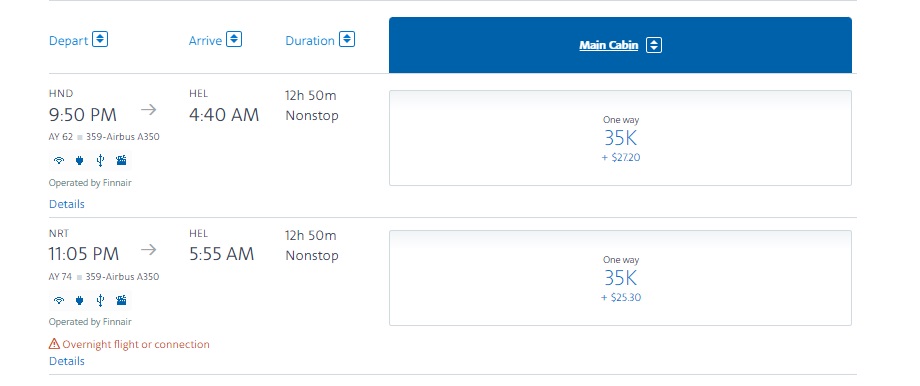
Helsinki to New York for 12K or 20K miles
Closing the loop and getting back to New York presents a couple of options, the better of which is likely subjective.
If you just want to consider using the fewest number of miles, then the best bet home from Helsinki would be via Virgin Atlantic Flying Club. You could fly from Helsinki to New York for just 12,000 miles, though it’ll also cost you almost $219 in taxes and fees.

Alternatively, you could book a route home like Helsinki to Stockholm to New York on SAS through Avianca LifeMiles for 20,000 miles. While the screen shot here shows ~$63 in taxes & fees, I believe this is before Avianca’s $25 partner award fee, which means you’d pay a total of about $88 in taxes and fees.
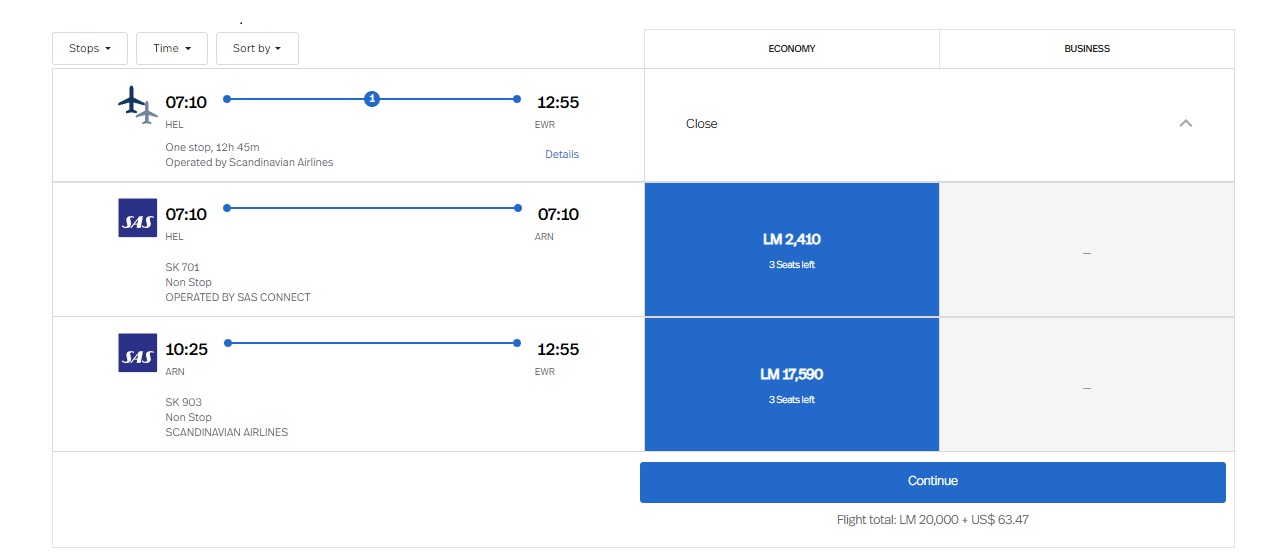
Which is the “better” deal is debatable. The Virgin Atlantic award saves you 8,000 miles while costing about $130 more in taxes and fees, which is a toss-up in my book. Of course, if you got your Virgin Atlantic miles courtesy of a transfer bonus, I could see that giving the edge to Virgin Atlantic.
Total: 77K + $256.45 (or 85K + $126.87)
Whether you use Virgin Atlantic or Avianca LifeMiles to get across the pond, the chance to fly all the way around the world for just 77K or 85K miles seems really solid. I actually realized after writing all of the above that it would be possible to skip the step in Hawaii and save 2,000 miles and $5.60 by flying from New York to Tokyo for 28K American Airlines miles and $5.60.
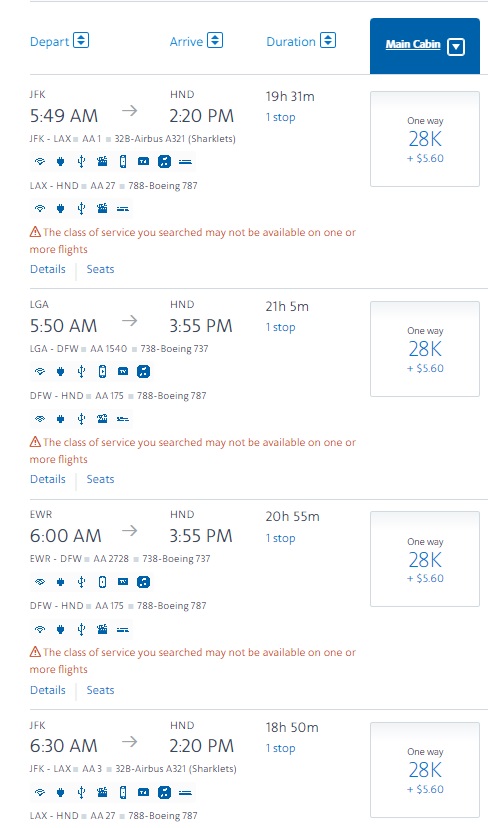
Again, that would save 2,000 miles and $5.60 over separately paying 7.5K miles + $5.60 to fly from Newark to Hawaii and then 22.5K Virgin Atlantic miles + $5.60 from Honolulu to Tokyo, which would drop the finally tallies to 75K or 82K. That said, I think we can agree to agree that adding Hawaii to the trip for 2,000 additional net miles and $5.60 is worth it.
All of the tallying above assumes that you value miles equally between programs. In reality, you probably don’t assign the same exact value to American Airlines miles as you do Virgin Atlantic miles or miles in other programs, but nonetheless this provides a decent benchmark against which to compare.
How does the ANA around the world chart stack up?
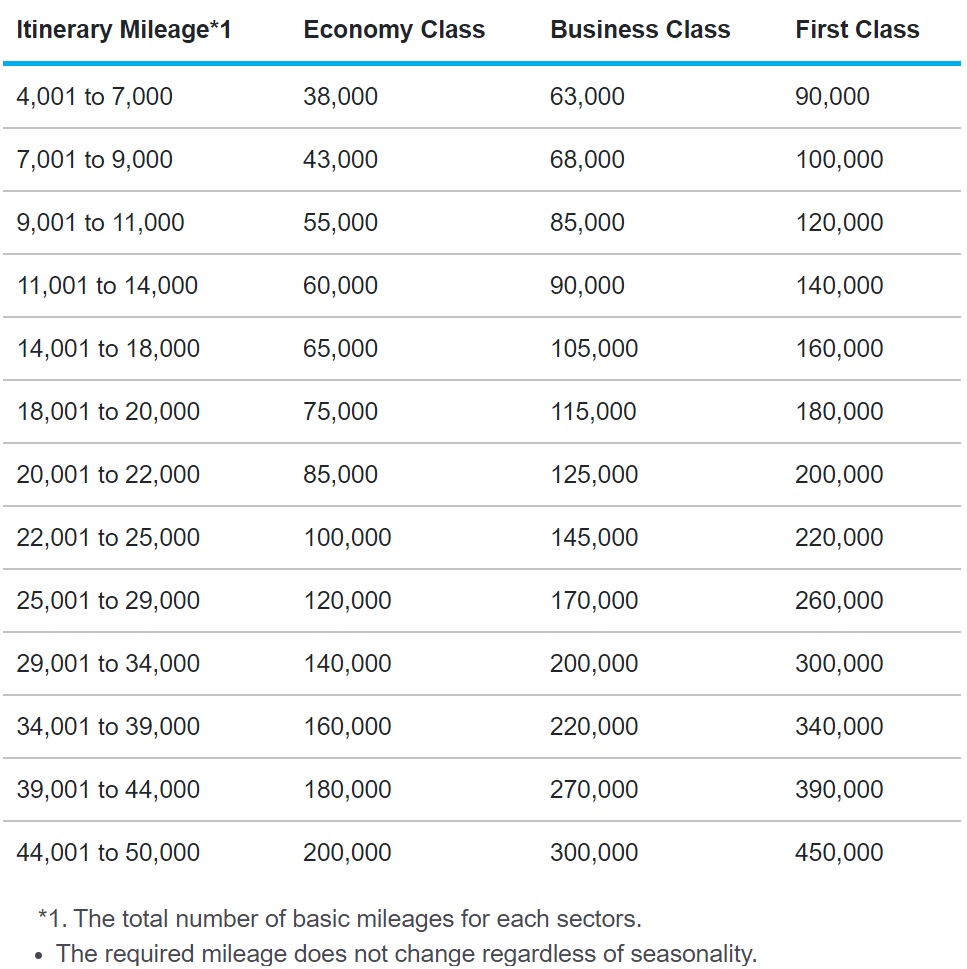
ANA’s around-the-world award chart has long been a darling of the award travel community thanks to the fantastic business class pricing, particularly in the mileage bands between 18,000 and 29,000 miles flown. Truthfully, I’d never spent much time considering the possibilities on the economy class side.
To get the “best deal”, I think it makes sense to focus on the distance band from 14,000 to 18,000 miles flown. An award covering that distance costs 65,000 miles.
One drawback of the ANA program is that they do pass along surcharges. That can make business class awards on Lufthansa Group metal unappealing. I’m honestly not sure how high those surcharges are on economy flights, but I built the following theoretical round-the-world trip avoiding airlines known to levy high surcharges:

This trip would be:
- Newark (EWR) to Paris(CDG) on United Airlines
- Paris (CDG) to Delhi, India (DEL) on Air India
- Delhi, India (DEL) to Bangkok, Thailand (BKK) on either Air India or Thai Airways
- Bangkok, Thailand (BKK) to Taipei, Taiwan (TPE) on Thai Airways or EVA Air
- Taipei, Taiwan (TPE) to Tokyo, Japan (NRT or HND) on EVA Air (or ANA with more surcharges)
- Tokyo, Japan to Guam (GUM) on United Airlines
- Guam (GUM) to Honolulu, Hawaii (HNL) on United Airlines
That itinerary would cost 65K miles. I’m not positive about the taxes and fees in total, but they should be very reasonable since I do not believe you’d be on the hook for any surcharges but rather you’d just be paying required taxes.
Looking at the map, one would surely notice that the circle is not complete. Greg showed during planning stages for the 3 Cards 3 Continents challenge that it is possible to “complete” an ANA around the world award by departing from the east coast of the US and “returning” to the country of origin in Hawaii.
Adding the flight from Honolulu back to New York would significantly increase the cost of the ANA round-the-world ticket since that flight distance is nearly 5,000 miles. In this case, that would bump you into the 22,000 to 25,000 miles flown distance band, which costs 100K miles in total — increasing the total cost of the award by 35K miles.
Instead, complete the loop back to New York with a separate Turkish Miles & Smiles award from Honolulu to Newark for 7.5K miles and $5.60 and you’re around the world to 7 different cities for 72,500 total miles. Wow!
While the ANA round-the-world award chart only saves a moderate number of miles over what I built above, it gets you to far more cities. With the ANA award, you would be able to stop and visit Paris, Delhi, Bangkok, Taipai, Tokyo, Guam, and Honolulu for as long as you like in each city (as far out as the booking calendar allows). More impressive yet is the thought that a single credit card welcome bonus could make the flights for that trip (up to the Honolulu stop) possible for one person — or maybe even for two people depending on the offer you pursue.
A clear limitation of the ANA route is that the only reasonable way to accumulate ANA miles is by transferring from American Express Membership Rewards. Other mileage currencies won’t make this booking possible.
On the other hand, the trip I built with separate award chart sweet spots would require having multiple distinct currencies — at the very least, you would need two (American Airlines miles and a currency like Capital One Miles or Citi Thank You points that can transfer to both Turkish and Virgin Atlantic). I suppose it would alternatively be possible to put together that trip with Bilt Rewards points given that Bilt transfers to American Airlines AAdvantage, Virgin Atlantic, and Turkish Miles & Smiles.
Is it worth paying more for business class?
I think the above examples really beg the question “Is it worth paying more for business class?”. Of course the face-value answer to the question will vary from one person to another, but in looking at the numbers I think one can see why ANA’s business class pricing gets more attention.
In the ANA example above, booking that trip in business class would cost an additional 40,000 miles on the ANA side (and an additional 5,000 miles if you could find the route from Hawaii in business class via Turkish). Flying the entire ANA award itinerary in business class wouldn’t even cost double the miles of an economy class award but rather about 61% more miles. That’s certainly not a small increase in the number of miles required, but on the other hand it is far less than the difference in cash cost between booking revenue fares in economy class versus business class. If you value any of the bells and whistles of business class, I think it is hard to ignore how much more value you’ll get out of using an additional 40,000 miles in that spot.
On the other hand, finding availability in business class will certainly be more challenging, particularly if you are traveling with a family. And since the difference is 40K miles per passenger, the total can add up quickly with multiple passengers. Again, whether it makes more sense to “splurge” on business class is a question that only you can decide for yourself.
Bottom line
This was just a fun little exercise because I’d never really considered how much it would cost to put together an economy class around-the-world ticket and I wondered whether ANA would still produce the better deal than booking separately. The bottom line is that it is pretty amazing to think how much flying you could do with relatively few miles.
I’m curious if any readers can put together an even better itinerary combining award chart sweet spots. What would be your best economy class round-the-world trip? Let us know in the comments.


I did around the world trip in 2010 with my daughter and at that time her husband. I used 240,000 delta miles for all 3 of us. We left Charlotte, NC, Dallas Texas, South Korea, Sydney, Australia, Perth Australia, Dubai, Cairo, Johannesburg, Dubai, Paris, Atlanta and back to Charlotte.
Pray tell how you did that for 80K DL per person. Unless it is an award sale, on a good day 80K will barely get you to another continent, let alone a RTW. Even in 2010. Was that the RTW fare or individual segments?
This
How does ANA price the around the world award booking if some segments are in economy and some in business?
As business.
As an economy flier, I was excited to see this article! In full disclosure, if the difference between econ and biz isn’t too great, and if i’ve got the miles, I’ll sometimes spring for biz. But usually, for our family of 4, economy is as good as it gets.
Re your question, one sweet spot I noticed is that AA would charge 22.5K for NRT to TLV on Etihad, via Abu Dhabi… 40K in business, which is an example where it would be worth it if you have or can find the miles. From there, you might find an Air France award since Israel is considered part of Europe. Or you could use 13K avios to Helsinki, and home with the Finns – or 12.5K to MAD, and take Iberia home from there.
Fun read Nick, TY. Not a Amer X user, so guess ANA is out – what is considered 2nd best? Other than the seperate legs in your first example?
I appreciate your article covering ANA in economy, you guys talk mostly about business class, but some of your readers such as myself fly international in economy, either because we don’t enough miles or there is no availability.
I have been reading in the flyertalk forum about booking the ANA round the world ticket and it seems that it is difficult to find business class flights for all the segments and most people end up with mixing business and economy, quite often flying the transpacific or transatlantic in economy.
Is it worth it to pay more for business but not have all of the segments in business?
Slightly related question: is Finnair allowed to use Soviet airspace now that Finland is in NATO?
Finland? Never heard of it.
The Soviet Union is defunct, though there is a madman trying to reconquer its empire by force. As an economy flyer 95% of the time I like the article. The ANA rtw trip is one case where I’d likely go with business, if availability could be found.
For ANA round the world, does anyone know if ANA would allow you to start in the US and end in South America? That routing would cross both oceans but not end in the same continent or country so I’m not sure.
I believe you need to return to the same continent as you departed from but not the same country. So, no.
Ok, do it again but include the southern hemisphere 🙂